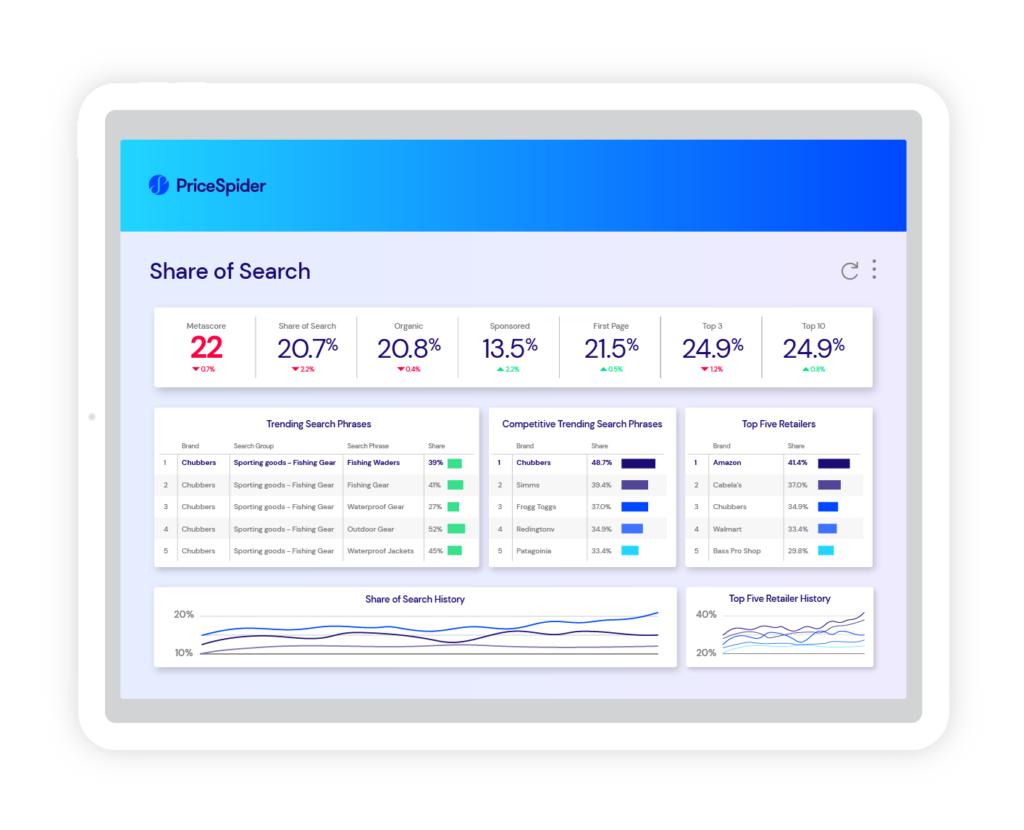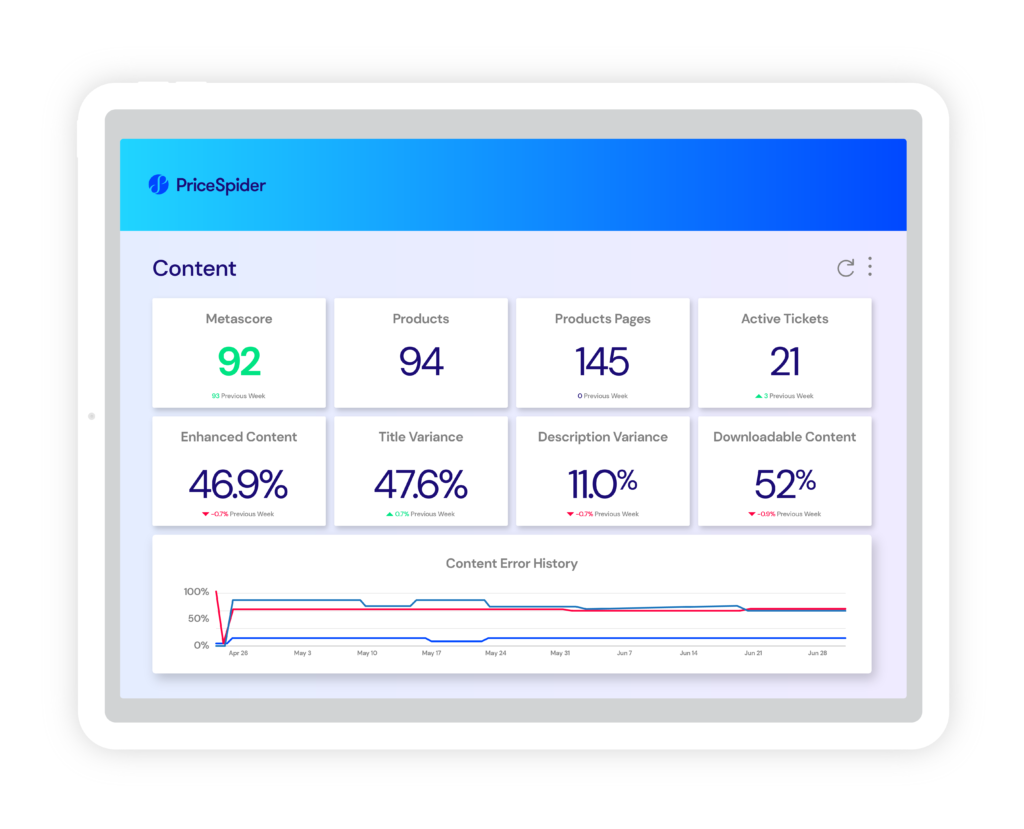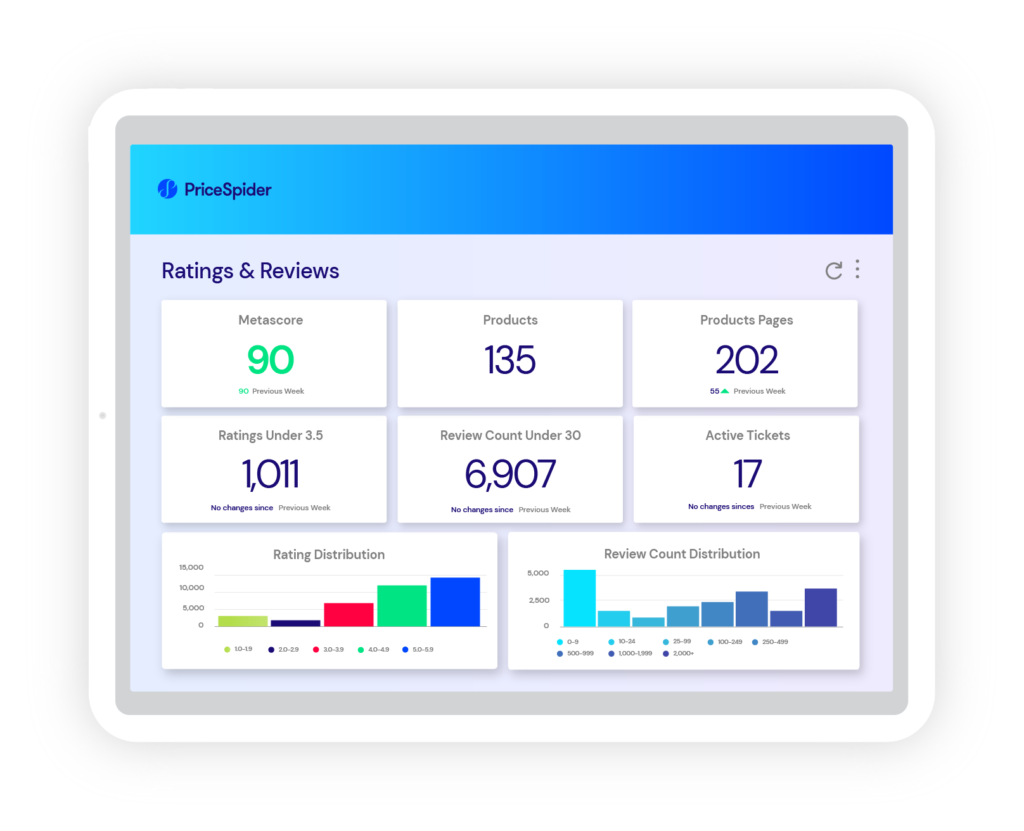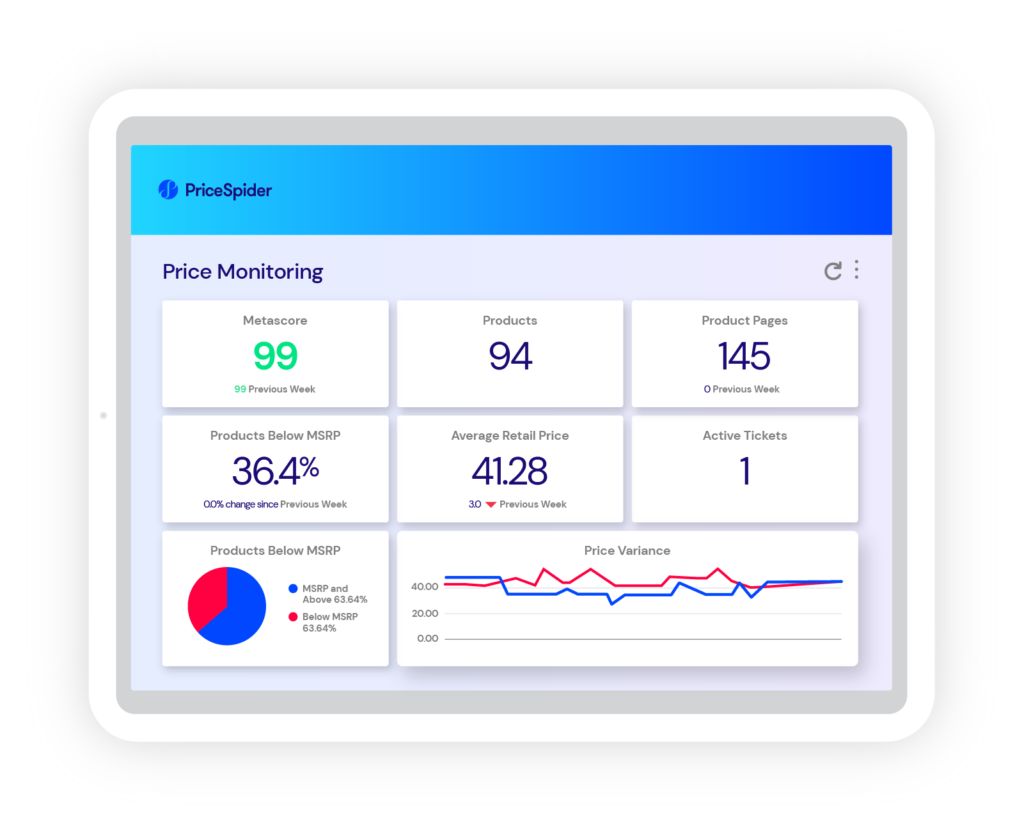You know the old saying, hindsight is 20-20? Well, I’ve always been of the opinion this is a massive understatement. Hindsight is more like x-ray vision or I may even boldly say it’s more like time travel. And while having visibility across the digital shelf maybe isn’t as valuable as time travel would be, keeping your eyes and ears on the digital shelf so that you keep your brand’s ecommerce machine running smoothly with fresh data insights is definitely akin to x-ray vision.
One of the biggest challenges with ecommerce is knowing how to track and measure your success. Besides sales, which metrics tell you how you’re doing? Sellers don’t share the impressions, views, or conversion rates on your product pages. They don’t even tell you which keywords are most popular for your product category.
Thankfully, you don’t have to rely on retail partners and third-party sellers to collect digital shelf data. You can get it yourself. While you can manually observe the digital shelf, the scale of most ecommerce operations makes manual data collection extremely tedious and inefficient. You could have thousands of SKUs listed on hundreds of websites. Most brands don’t have time to have employees monitor every product page—and even if they did, human errors and lack of organization would make this data a lot less useful.
Because of this, leading brands are turning to digital shelf analytics software like Brand Monitor. These tools automate data collection and organize the information in ways you can actually use. But since many of these solutions collect different kinds of data, the challenge for brands is knowing what is worth analyzing and what it enables you to do.
In this guide, we’ll look at the most valuable data you can collect and how you can use it to improve your digital shelf performance. But first, what is digital shelf data? What sets these metrics apart from other types of ecommerce-related data?
What is digital shelf data?
Digital shelf data is objective, quantifiable facts about how well your product pages are doing on the digital shelf. It includes keyword rankings, content compliance, product ratings, review sentiment, stock information, and prices.
These statistics tell you about your products’ position, performance, and perception on retail websites and online marketplaces. Whether it’s aggregate data from every site you sell on, or isolated to a specific storefront, digital shelf data helps you understand how consumers interact with your products online and how well your product pages represent your brand.
Here’s what kind of data you should collect.
Share of Search
For every product you sell, there are a handful of keywords and phrases consumers use to find items like it. Your position in search results for these terms is unique to each retail site, and it’s one of the most critical pieces of digital shelf data you can track. If you don’t rank for these terms, you’re losing significant sales every day. Even small changes can have a major impact on your bottom line. Your rankings naturally fluctuate as competitors optimize their product pages, consumers interact with the results, ratings change, and brands come and go.
Your Share of Search is your position over time for the keywords that matter to your products. To monitor it manually, you’d have to check every keyword for every product on every site every day, then compile your findings in a spreadsheet. PriceSpider’s Brand Monitor tracks your Share of Search automatically, enabling you to simply review your position periodically. You can explore your rankings by date range, and you can see whether your position comes from organic results or advertising. It’s also possible to look at Share of Search for competitors, making it a valuable competitive research tool.

Stock availability
If people can’t buy your products, your pages aren’t going to convert. In fact, when those out-of-stock product pages appear in search results, people won’t click on them, either. So your rankings will slip, and your sales will fall. It’s hardly unusual for products to go out-of-stock, but it’s important to pay attention to where they’re going out of stock and for how long, so you can make adjustments to your supply chain and minimize downtime.
Typically, products don’t stay out-of-stock for long. So if you’re trying to manually track your catalog’s availability across all channels, you’ll miss some of the moments when people can’t buy your products. This is another area where digital shelf analytics solutions come to the rescue. Brand Monitor crawls your product pages in real-time, so it detects the moment your products (or your competitors’) go out-of-stock.
As we’ll discuss in a moment, tracking stock availability also creates timely opportunities to optimize your ad spend.
Content compliance
Imagine if a customer clicked on your product page, and there were no details about your product. Or the description looked like it was generated by a robot. Or the hero image looked nothing like your product. Your product title, description, images, and other assets have a significant effect on your product page performance. Not to mention, they set expectations for the consumer—so incorrect assets could seriously mislead them.
If you’re like most brands, you work hard to optimize product page content both for the keywords that matter and the benefits that are most persuasive to your customers. You want your products to look and sound as good as they can, and represent your brands well. So it’s frustrating when sellers create their own assets or fail to keep this information up-to-date.
But look at two product pages for the same SKU side-by-side, and it can be tough for human eyes to spot the differences. You might not see that mention of an old feature—or that the new feature isn’t mentioned. You may not notice when a seller is still using a description that’s been problematic in the past.
Now multiply this challenge across every product in your catalog and every site you sell on. Mistakes are inevitable. And each one has the potential to weaken your brand integrity, inhibit your performance, and mislead customers.
Using a master copy of your product pages, Brand Monitor can automatically analyze how well each seller follows your brand guidelines. Not a single typo or missing sentence goes unnoticed. And unlike other content auditing tools, Brand Monitor even uses image recognition to ensure your visual assets are correct and in the right position.

Every product page receives a compliance score based on how well it follows your guidelines, so you can easily see which sellers are keeping your product pages up-to-date, and which ones are holding you back.
Ratings and reviews
Good ratings help your products stand out from the competition. They also help you rank for the terms you’ve optimized for. And when customers leave you authentic, glowing reviews, that means more to prospective customers than even the best marketing copy. You can certainly monitor your ratings and reviews manually, but if you want to turn this information into insights, you’ll need to organize it—and that can take a lot of work.
Aggregate ratings give you far more data about how your products are perceived by all your customers, not just a single site. And scanning aggregate reviews for trends and common descriptions reveals the handful of things customers say about your products most often. Narrowing down ratings and reviews by date range can show you exactly when sentiments shifted, or if changes to your product affected your customers’ experience with it.
With Brand Monitor’s Ratings & Reviews feature, all you have to do is turn on the filters you want, and you can explore this valuable digital shelf data from a variety of angles.

Pricing
Creating a pricing policy won’t stop sellers from driving down your prices. You have to monitor (and enforce) your policy to make it meaningful. Some sellers are willing to honor the document because they respect their relationship with you. But others will act like your policy doesn’t exist if there aren’t consequences attached to it. When they do that, everyone else has to violate your price, too, or they’ll lose sales. Then say goodbye to your margins and adios to your brand integrity.
Price is one of the biggest factors consumers use to make buying decisions—especially with brands they aren’t familiar with. But you want your sellers to compete to provide a better experience, not a lower price. If all your sellers are racing to the bottom, your customers will be less willing to pay regular price when you correct the problem.
Unfortunately, with repricing software, sellers can automate price changes, and it can be extremely difficult to catch policy violations. But Brand Monitor sees your prices in real-time, so you’ll always see when a seller lists your products for too low—even if it’s only for a moment.

How to use digital shelf data
Tracking and analyzing the right digital shelf data is only half the battle. The value of that analysis completely depends on what you can do using what you learn. How do you turn those insights into action?
Optimize for retailer search engines
The whole point of Share of Search is to see whether you’re gaining or losing ground in search rankings over time. If the data shows that you’re falling behind on keywords you used to rank for, you need to investigate why and then adjust your content accordingly. Which competitors took your place? When you compare your product pages to your competitors, what’s the difference? Do they mention the keywords more than you? Are there key differences in the product title? Do their descriptions and supporting copy seem more relevant to the target phrases or categories?
If your competitor is clearly using a different strategy that’s working better than yours, it might be time to use a play out of their playbook. Put your own branded spin on what they’re doing well.
Other times, your copy might be fine, and your low ratings are at fault. In that case, you may want to nudge your customers to leave reviews on that website. Or maybe they’re getting more branded search, which makes them look like a better result for your category. You might need to drive traffic to that storefront for a while, or focus on increasing your brand awareness.
Perhaps you recently made a major change to your product page which coincides with the decline in rankings. (It wouldn’t be the first time it’s happened!) If so, you’ll probably want to revert as many of those changes as you can.
It’s extremely difficult to win the digital shelf without winning in search. So if you’re falling behind, you need to pull all the stops to make your pages look like the best result for your categories.
Enforce your brand guidelines
Sometimes retailers give you a product information management (PIM) system, letting you manage product page content yourself. Other times they don’t, and you have to push the changes through a representative. Either way, it’s worth enforcing your guidelines to ensure that your product page copy, images, and videos are all up-to-date on every site you work with. Every variant has the potential to cause harm. And once you’re aware they exist, you can use that knowledge to persuade your rep that making the updates are worth their time. Without accurate, up-to-date digital shelf data, enforcing your brand guidelines is nearly impossible.
Capitalize on timely ad opportunities
The moment your product goes out of stock, any ad spend applied to that product page is a waste. So turn it off. Nobody can buy that product while it’s unavailable, so why spend money to send people there?
The moment your competitor’s product goes out of stock, you have a window of opportunity. People who search for this product by name won’t be able to buy it. And that makes this the perfect time to advertise on this competitor’s branded keywords. Then when people look for them, they’ll find you.
Normally, advertising on branded keywords isn’t very effective. These people are looking for a specific brand after all. But when that brand isn’t available, they have to decide to go to a different site, give up, or buy something else that meets their needs. And if you’re the first result besides the out-of-stock brand they’re looking for, you just made things easier for them.
So track your stock availability to avoid wasting your ad budget, and track your competitor’s stock availability to win over some of their customers.
React to ratings and reviews
Looking at your average ratings on a seller’s site, you might not notice bad ratings trickling in. But if you look at ratings over time and see a huge spike in one-star ratings over the last week or month, it’s time to take a closer look at what people are saying about your products. There could be a problem with your carrier that’s causing orders to arrive damaged. Or maybe a defect slipped through. Perhaps your last product page update included a claim customers have found misleading.
The longer you let the problem persist, the bigger it’s going to become. With fast reactions to declines in ratings, you can prevent a temporary issue from having a lasting effect on your performance.
Enforce your pricing policy
Your pricing policy only makes a difference if you enforce it. If sellers see that there are no consequences for violating your policy, they have no reason to stop. A well-crafted pricing policy should lay out clear penalties for violations. Once you start monitoring your prices, it’s time to start dishing out penalties, too. It doesn’t matter how close your relationship is with a partner. A violation is a violation, and you can’t play favorites.
Let violators treat your prices like they don’t matter, and eventually your brand won’t matter, either.
Start analyzing digital shelf data
Brand Monitor is a comprehensive digital shelf analytics solution. It’s your one-stop-shop for collecting digital shelf data and evaluating your performance on the shelf. With tools like Share of Search, content compliance monitoring, MAP monitoring, stock availability tracking, and ratings and reviews analysis, you’ll have all the digital shelf data you need to take action and improve your position.
Want to see what Brand Monitor can do for you? See the free on-demand webinar, “How Brands can Leverage Digital Shelf Analytics Technology to Maximize Ecommerce Performance.”

